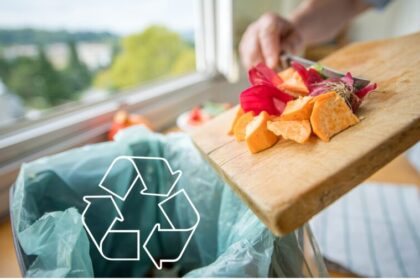Local recyclability Infrastructure
Living in Chicago, you may have noticed the changes in policies regarding recycling and what can be recycled. For example, plastic bags were banned in 2017 from the Blue Cart program and the additional fee increase for them was expected to result in a 27.7% decrease in plastic bag generation from grocery stores (Chicago.gov). As of 2020, Chicago had an 8.83% recycling rate (Chicago.gov) which is below the 2020 national average of 32% (epa.gov), but the 8.83% is an increase compared to previous years in Chicago. The current changes can be attributed to recent technological advances and how it has impacted packaging sustainability. Although there have been many advances, there are many packaging material combinations in the market today that are not properly labeled and consumers are very confused about recyclability.
In addition, we are seeing an influx of “eco-friendly”, “green” and “biodegradable” claims from online packaging vendors, but what does that mean? If a business owner called the vendors to ask, they would be speaking to a sales rep, who is not 100% knowledgeable about the end of life of the packaging. For example, I called a vendor the other day, and I asked twice whether the packaging I was interested in was recyclable. This packaging had multiple parts and a combination of different materials. The rep’s answer each time was that the packaging was not compostable. We noticed that technology is advancing, but not enough training can mislead clients very easily. This clearly exemplifies the knowledge gap that exists today and the lack of knowledge about the end of life of different packaging products labeled “green”, “biodegradable” and “eco-friendly”.
Clarifying marketing terminology surrounding sustainable packaging
By definition, eco-friendly is something that is not harmful to the environment. The problem with companies labeling packaging as “eco-friendly” is because it is not always safe for the environment. Foodinsight.org describes eco-design packaging as products containing less plastic while keeping the integrity of the original product. However, less plastic does not guarantee no plastic or eco-safe materials. Unless a company specifies every material used in a product’s packaging and the impact it will have on the environment, there is no way to know if it is truly eco-friendly.
As for biodegradable, it is defined as something that is capable of being decomposed by bacteria or other living organisms when exposed to sunlight, air, and moisture. Some examples of biodegradable items are food and leaves. A big problem with labeling packaging as “biodegradable” according to consumer.ftc.gov is not labeling how long the packaging takes to decompose and how much will be decomposed within a specific time frame. The best-case scenario is full biodegradability inside a home compost bin or at an industrial composting facility. Even though a packaging is labeled compostable, it doesn’t mean it will be a good fit for a home compost bin.
Many times, these biodegradable products end up in landfills and do not have a chance to fully decompose because of the lack of awareness about the materials in the packaging and what it takes for them to fully decompose. Another issue surrounding labeling packaging as “biodegradable” is companies using materials that are only biodegradable with certain circumstances and not making buyers aware of the special circumstances needed for their packaging to decompose properly. Once again, there is a lack of communication creating a knowledge gap. So, what can businesses do to keep packaging and products natural looking and environmentally friendly?
Disposal challenges with Look-alike packaging products
When food service thinks about having a natural look for the packaging, some business owners might gravitate towards kraft paper vs Styrofoam or plastic containers. Bakeries, Meal prep and restaurants will probably be looking for oil and moisture-resistant materials. Today’s take-out containers and bakery boxes are made from paper with different barriers that look-alike. Some use polyethylene, others have plant-based PLA, and others are made with re-pulpable certified barriers. The problem is that all these materials can’t be disposed of equally. This lack of equal distribution is one of the big reasons Chicago has experienced a low percentage of recycling. When too many different materials get inter-mixed with recyclable items, the recycle bin is labeled as contaminated and is no longer able to be taken for recycling. Unfortunately, in 2019 it was estimated that over 500,000 blue recycle bins were labeled as contaminated for private haulers alone, which means the number would be greater when including the public haulers contaminated bins.
Another example of this situation of looking for natural materials to use as alternatives is when a food processor is looking for compostable pouch or they use a compostable pouch, but they also use a label that is made out of a non-compostable material. By using a non-compostable material for a label, like adhesive, it contaminates the composting process. Although the entire product and packaging may be capable of being composted, the label itself would not and would therefore contaminate the process and damage the environment. It is very important to understand that in order to invest in environmental justice it is important to work with an expert who can guide you through the process of making the right decisions in the shortest amount of time. This will help you be more assertive in implementing the best packaging choice for your business.
When we look at produce containers in the grocery store, it is unimaginable to think that most of the containers use paper labels, vs. recyclable labels – labels made out of plastic. The paper labels contaminate the recycling process for PET pellets to enter a new cycle as post-consumer PET. PET produce containers are made exactly with the same material as plastic bottles, but the difference is on the label material. For this reason, post-consumer water bottles have a higher recyclability rate compared to produce clamshells. Although recycling is not where it should be in Chicago, the amount of plastic bottles and plastic in general is majority of what is recycled. The US EPA, Environmental Protection Agency, stated that as of 2020 the plastic waste generation had increased by 13.6%, but the recycling rate also increased from 8.0% to 8.83% (Chicago.gov). Instead of blindly trusting what the labeling says or trying to communicate with the sales reps with knowledge gaps, you need someone who knows about the different packaging, what is most environmentally friendly, and someone who you can trust overall to help you make smart environmentally friendly, ethical business decisions.
How to approach this overwhelming confusion?
MB Consulting’s expert support can help you and your business. I have developed produce packaging for almost 15 years. Part of this packaging included new PET container designs, new box designs, working with design teams and the manufacturer level, as well as graphic designers for packaging labels. As brand owners, we are very focused on keeping the integrity of the product we sell. We want to ensure the longest shelf life, the easiest distribution at the retailer and the best shopping experience for the consumers of our products. However, this linear thinking has caused a plastic pollution crisis. Besides climate change, there are other environmental impacts from plastic pollution such as groundwater contamination and injuring and killing animals. Not only have we have failed to inform the consumer what to do with the packaging after our products are used or consumed, but we have failed to inform them about the impacts our packaging can have.
When you think about sustainable packaging for your brand, you need to think beyond your product. This idea of thinking beyond your product means you must invest in technical knowledge to help you source the correct materials and to help your clients through your packaging. However, having sustainable packaging is not the only thing that goes into a brand being fully sustainable. A brand is fully sustainable when they fully understand the source of the packaging materials and the end of life of their packaging. Sustainability is not only good for the environment, but it will have positive impacts on your business as well.
What is the ROI for investing in sustainable packaging consultation?
When considering sustainability expertise, you may not think your company would experience much growth and it would only benefit the environment. However, research has proven otherwise. The 2021 Global Buying Green Report found that 67% of consumers think it is important for packaging to be recyclable and 54% consider sustainable packaging when purchasing products (2021 Global Buying Green Report). Another study from 2020 by Shorr Packaging found that more people began paying attention to their products’ packaging being sustainable during the pandemic and about 58% reported that they would be “likely” or “very likely” to choose products that have sustainable and recyclable packaging materials (2021 Global Buying Green Report). Understanding your consumers is key to running a good business and gaining sales, and as research has shown, consumers want sustainable packaging and materials.
Conclusion
If you want to help the environment and increase sales for your business, sustainable packaging and materials is for you. However, before making that leap you will need a consultant to help you make the best decisions for your packaging and your business.
Email us at info@mbconsultingus.com with information about your project. We will get in touch with you as soon as possible. We work with small and medium size growers, food processors, independent retailers and food service clients. We look forward to working with you!
Resources
https://www.chicago.gov/content/dam/city/progs/env/Chicago-Waste-Strategy/UIC-Report-7.12.21.pdf (pg 35)
https://www.chicago.gov/dam/city/depts/doe/general/RecyclingAndWasteMgmt_PDFs/BlueCart/BlueCartRecycling_BlueCart_Text.pdf
https://www.chicago.gov/city/en/depts/streets/supp_info/recycling1/Landfill_Diversion_Rates.html
https://www.epa.gov/recyclingstrategy/national-recycling-goal-recycling-rate-measurement-comment-period#:~:text=As%20currently%20calculated%2C%20the%20national%20recycling%20rate%20is%2032%25.
https://www.consumer.ftc.gov/articles/eco-friendly-and-green-marketing-claims#how
https://www.nytimes.com/interactive/2020/10/01/climate/biodegradable-containers.html
https://foodinsight.org/what-you-may-not-know-about-sustainable-packaging/
https://www.ehn.org/plastic-environmental-impact-2501923191/plastic-manufactured-in-the-first-10-years-of-this-century-eclipses-the-total-produced-in-the-entire-last-century
https://www.convenience.org/Media/Daily/2021/Apr/29/6-Consumers-Demand-Sustainable-Packaging_Research
https://blockclubchicago.org/2020/01/27/chicagos-dismal-recycling-rate-targeted-by-mayor-who-wants-to-study-how-other-cities-do-it-better/




